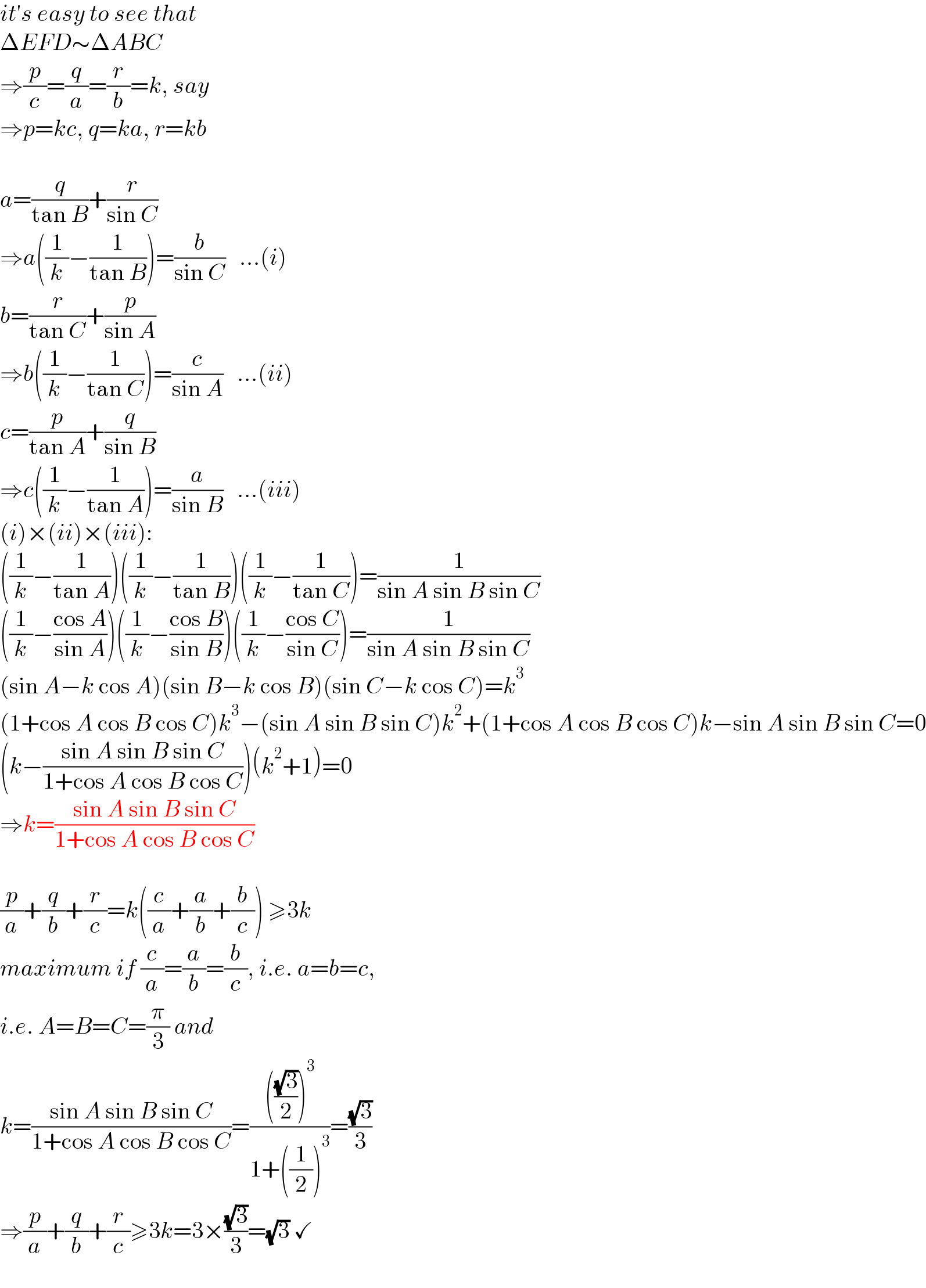
Question Number 169585 by Shrinava last updated on 03/May/22

Commented by mr W last updated on 03/May/22

$${please}\:{check}\:{the}\:{question}!\:{one}\:{can}'{t} \\ $$$${image}\:{how}\:{it}\:{looks}\:{like}.\:{maybe} \\ $$$${D}\:{on}\:{BC},\:{E}\:{on}\:{CA}\:{and}\:{F}\:{on}\:{AB}. \\ $$
Commented by Shrinava last updated on 03/May/22

$$\mathrm{Sorry}\:\mathrm{professor},\:\mathrm{yes}\:\mathrm{will}\:\mathrm{be}\:\mathrm{as}\:\mathrm{you}\:\mathrm{say} \\ $$
Answered by mr W last updated on 03/May/22

Commented by mr W last updated on 03/May/22

$${it}'{s}\:{easy}\:{to}\:{see}\:{that} \\ $$$$\Delta{EFD}\sim\Delta{ABC} \\ $$$$\Rightarrow\frac{{p}}{{c}}=\frac{{q}}{{a}}=\frac{{r}}{{b}}={k},\:{say} \\ $$$$\Rightarrow{p}={kc},\:{q}={ka},\:{r}={kb} \\ $$$$ \\ $$$${a}=\frac{{q}}{\mathrm{tan}\:{B}}+\frac{{r}}{\mathrm{sin}\:{C}} \\ $$$$\Rightarrow{a}\left(\frac{\mathrm{1}}{{k}}−\frac{\mathrm{1}}{\mathrm{tan}\:{B}}\right)=\frac{{b}}{\mathrm{sin}\:{C}}\:\:\:...\left({i}\right) \\ $$$${b}=\frac{{r}}{\mathrm{tan}\:{C}}+\frac{{p}}{\mathrm{sin}\:{A}} \\ $$$$\Rightarrow{b}\left(\frac{\mathrm{1}}{{k}}−\frac{\mathrm{1}}{\mathrm{tan}\:{C}}\right)=\frac{{c}}{\mathrm{sin}\:{A}}\:\:\:...\left({ii}\right) \\ $$$${c}=\frac{{p}}{\mathrm{tan}\:{A}}+\frac{{q}}{\mathrm{sin}\:{B}} \\ $$$$\Rightarrow{c}\left(\frac{\mathrm{1}}{{k}}−\frac{\mathrm{1}}{\mathrm{tan}\:{A}}\right)=\frac{{a}}{\mathrm{sin}\:{B}}\:\:\:...\left({iii}\right) \\ $$$$\left({i}\right)×\left({ii}\right)×\left({iii}\right): \\ $$$$\left(\frac{\mathrm{1}}{{k}}−\frac{\mathrm{1}}{\mathrm{tan}\:{A}}\right)\left(\frac{\mathrm{1}}{{k}}−\frac{\mathrm{1}}{\mathrm{tan}\:{B}}\right)\left(\frac{\mathrm{1}}{{k}}−\frac{\mathrm{1}}{\mathrm{tan}\:{C}}\right)=\frac{\mathrm{1}}{\mathrm{sin}\:{A}\:\mathrm{sin}\:{B}\:\mathrm{sin}\:{C}} \\ $$$$\left(\frac{\mathrm{1}}{{k}}−\frac{\mathrm{cos}\:{A}}{\mathrm{sin}\:{A}}\right)\left(\frac{\mathrm{1}}{{k}}−\frac{\mathrm{cos}\:{B}}{\mathrm{sin}\:{B}}\right)\left(\frac{\mathrm{1}}{{k}}−\frac{\mathrm{cos}\:{C}}{\mathrm{sin}\:{C}}\right)=\frac{\mathrm{1}}{\mathrm{sin}\:{A}\:\mathrm{sin}\:{B}\:\mathrm{sin}\:{C}} \\ $$$$\left(\mathrm{sin}\:{A}−{k}\:\mathrm{cos}\:{A}\right)\left(\mathrm{sin}\:{B}−{k}\:\mathrm{cos}\:{B}\right)\left(\mathrm{sin}\:{C}−{k}\:\mathrm{cos}\:{C}\right)={k}^{\mathrm{3}} \\ $$$$\left(\mathrm{1}+\mathrm{cos}\:{A}\:\mathrm{cos}\:{B}\:\mathrm{cos}\:{C}\right){k}^{\mathrm{3}} −\left(\mathrm{sin}\:{A}\:\mathrm{sin}\:{B}\:\mathrm{sin}\:{C}\right){k}^{\mathrm{2}} +\left(\mathrm{1}+\mathrm{cos}\:{A}\:\mathrm{cos}\:{B}\:\mathrm{cos}\:{C}\right){k}−\mathrm{sin}\:{A}\:\mathrm{sin}\:{B}\:\mathrm{sin}\:{C}=\mathrm{0} \\ $$$$\left({k}−\frac{\mathrm{sin}\:{A}\:\mathrm{sin}\:{B}\:\mathrm{sin}\:{C}}{\mathrm{1}+\mathrm{cos}\:{A}\:\mathrm{cos}\:{B}\:\mathrm{cos}\:{C}}\right)\left({k}^{\mathrm{2}} +\mathrm{1}\right)=\mathrm{0} \\ $$$$\Rightarrow{k}=\frac{\mathrm{sin}\:{A}\:\mathrm{sin}\:{B}\:\mathrm{sin}\:{C}}{\mathrm{1}+\mathrm{cos}\:{A}\:\mathrm{cos}\:{B}\:\mathrm{cos}\:{C}} \\ $$$$ \\ $$$$\frac{{p}}{{a}}+\frac{{q}}{{b}}+\frac{{r}}{{c}}={k}\left(\frac{{c}}{{a}}+\frac{{a}}{{b}}+\frac{{b}}{{c}}\right)\:\geqslant\mathrm{3}{k} \\ $$$${maximum}\:{if}\:\frac{{c}}{{a}}=\frac{{a}}{{b}}=\frac{{b}}{{c}},\:{i}.{e}.\:{a}={b}={c}, \\ $$$${i}.{e}.\:{A}={B}={C}=\frac{\pi}{\mathrm{3}}\:{and} \\ $$$${k}=\frac{\mathrm{sin}\:{A}\:\mathrm{sin}\:{B}\:\mathrm{sin}\:{C}}{\mathrm{1}+\mathrm{cos}\:{A}\:\mathrm{cos}\:{B}\:\mathrm{cos}\:{C}}=\frac{\left(\frac{\sqrt{\mathrm{3}}}{\mathrm{2}}\right)^{\mathrm{3}} }{\mathrm{1}+\left(\frac{\mathrm{1}}{\mathrm{2}}\right)^{\mathrm{3}} }=\frac{\sqrt{\mathrm{3}}}{\mathrm{3}} \\ $$$$\Rightarrow\frac{{p}}{{a}}+\frac{{q}}{{b}}+\frac{{r}}{{c}}\geqslant\mathrm{3}{k}=\mathrm{3}×\frac{\sqrt{\mathrm{3}}}{\mathrm{3}}=\sqrt{\mathrm{3}}\:\checkmark \\ $$
Commented by Shrinava last updated on 04/May/22

$$\mathrm{As}\:\mathrm{always},\:\mathrm{the}\:\mathrm{perfect}\:\mathrm{solution}, \\ $$$$\mathrm{thank}\:\mathrm{you}\:\mathrm{so}\:\mathrm{much}\:\:\mathrm{Professor} \\ $$
Commented by Tawa11 last updated on 04/May/22

$$\mathrm{Great}\:\mathrm{sir} \\ $$
